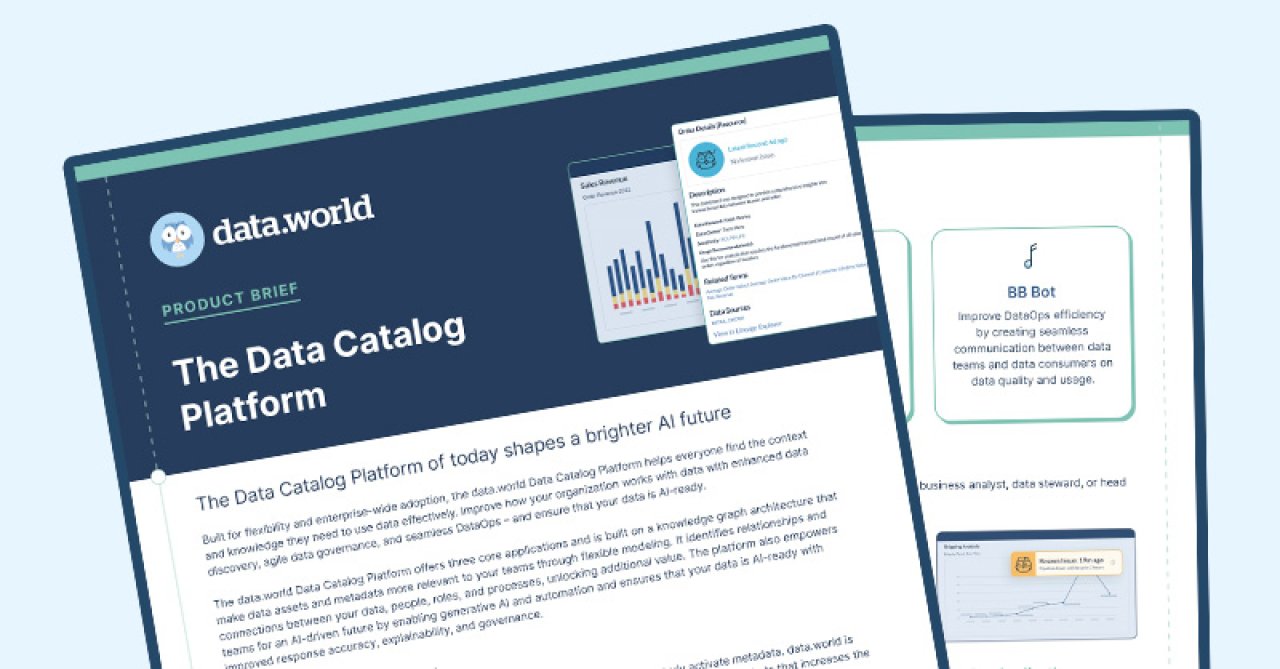







Feb 06, 2025

Augmented data discovery is a modern approach that uses automation to manage massive datasets. Unlike traditional methods that rely heavily on human effort and predefined queries, it uses intelligence and self-service tools to help users find and use data, even with limited technical expertise. By doing so, it is replacing time-consuming manual data discovery tasks.
This approach integrates these core technologies:
Natural Language Processing (NLP) for simple language search.
Automated insights generation for quick decision-making.
Anomaly detection to point out irregularities for faster and more reliable data-driven decisions.
Here's why this approach is becoming so popular.
In 2020, the augmented analytics market was valued at $8.95 billion and is projected to reach $91.46 billion by 2032. This growth shows the increasing importance of AI-augmented tools in data quality management and the advantages they offer, such as:
Augmented data discovery automates repetitive processes like data classification and cleaning. For example, a retail company can automatically categorize sales data from multiple stores with augmented data tools.
So, instead of manually sorting through spreadsheets or records to group data (e.g., by product category, region, or sales trends), the tools use AI to do this instantly. This frees up time for employees to focus on analyzing the insights rather than spending time on repetitive tasks.
With augmented data discovery tools, non-technical users can easily query data with easy-to-use interfaces and AI-powered features. This is helpful for marketing managers without coding skills, as they can use natural language queries to analyze customer sentiment on campaign strategies.
Augmented discovery dramatically reduces the time needed to discover insights and relevant data from a pile of raw datasets. This readiness is required in sensitive data industries like financial firms as they have to detect transaction data fraud patterns and minimize losses.
AI-based anomaly detection and automated data preparation improve data quality and reliability. Healthcare organizations use these tools to maintain accurate patient records and reduce the risk of errors in treatment plans and billing.
Below is a simple breakdown of how the augmented data discovery process works:
The process starts with ingesting data from all the sources (databases, cloud storage, and third-party applications). Then, AI and ML models automatically structure this data by clearing out errors and inconsistencies. After this, the data is ready for analysis without requiring extensive manual preparation.
Once the data is prepared, AI-driven metadata enrichment features automatically generate and catalog metadata. This makes your metadata context-rich, which is why searching for relevant data assets becomes easier.
ML models then analyze datasets to find patterns or correlations among data assets. For example, algorithms can identify seasonal sales trends or predict customer churn rates from a huge sales records set. These findings are surfaced through automated dashboards so users can spot both opportunities and challenges.
You don’t have to change your workflow to use augmented data discovery. These tools can connect with platforms like Tableau and Power BI to visualize insights without extra hassle. This means you can keep using the tools you’re familiar with while getting smarter, AI-driven insights to support better decision-making.
Now, let’s see where augmented data discovery is making a difference because it’s already helping companies across industries make smarter decisions.
Retailers like Amazon use augmented data discovery for predictive analysis to understand customer behaviors and optimize their pricing strategy and supply chain accordingly. This also makes it easier to create targeted marketing campaigns and improve customer satisfaction.
In healthcare, augmented analytics helps doctors review patient data for quicker diagnosis and optimizing treatment plans. It provides insights into patient health so doctors can make accurate decisions and give quality care in less time.
Marketing teams use augmented analytics to review campaign performance and improve their strategies based on these insights for better ROI.
Netflix is a prominent example of using augmented data discovery in its marketing strategies. It uses advanced data analytics and ML algorithms to personalize content recommendations and predict viewer preferences. This approach provides more tailored services to all users, which increases satisfaction and loyalty.
Financial institutions apply augmented analytics for fraud detection and investment strategy optimization. They use augmented data discovery to analyze large data volumes and show hidden patterns to anticipate customer behavior.
Man Group (a London-based hedge fund) developed ArcticDB — a proprietary data analysis tool to handle vast stock trade data. It integrates with existing data ecosystems and consistently analyzes huge datasets. This way, the company processes billions of financial data, including every tiny stock price change, in less time.
Manufacturers use augmented analytics to optimize production processes and predict maintenance needs. For example, they can predict equipment failures before they occur and specify when maintenance is needed, reducing downtime and maintenance costs.
To get the most out of the capabilities of augmented data discovery, make sure you go for data discovery tools that have the following features:
AI-driven insights and automation: Provide automated insights to reduce the need for manual hassle.
Robust metadata management and cataloging: Provides a centralized data catalog to simplify data asset search.
User-friendly interfaces: Has interactive design and natural language querying capabilities so non-technical users can also use it.
Simple integration: Compatible with popular analytics platforms like Tableau and Power BI, as well as databases and data warehouses.
Strong data governance: Provides role-based access control, data lineage tracking, and compliance with regulations such as GDPR and HIPAA.
data.world is a data catalog platform that makes data discovery easier and more efficient. It simplifies complex data environments using advanced metadata management, collaboration tools, and AI-driven insights. These features help teams find and use data without unnecessary complexity.
With data.world, organizations can break down data silos and improve teamwork. Its user-friendly interface and smart automation ensure you can manage large datasets with ease.
Ready to see how all of it works in real time? Schedule a demo now and automate your data management tasks with our augmented data discovery tools.

Augmented data discovery is a modern approach that uses automation to manage massive datasets. Unlike traditional methods that rely heavily on human effort and predefined queries, it uses intelligence and self-service tools to help users find and use data, even with limited technical expertise. By doing so, it is replacing time-consuming manual data discovery tasks.
This approach integrates these core technologies:
Natural Language Processing (NLP) for simple language search.
Automated insights generation for quick decision-making.
Anomaly detection to point out irregularities for faster and more reliable data-driven decisions.
Here's why this approach is becoming so popular.
In 2020, the augmented analytics market was valued at $8.95 billion and is projected to reach $91.46 billion by 2032. This growth shows the increasing importance of AI-augmented tools in data quality management and the advantages they offer, such as:
Augmented data discovery automates repetitive processes like data classification and cleaning. For example, a retail company can automatically categorize sales data from multiple stores with augmented data tools.
So, instead of manually sorting through spreadsheets or records to group data (e.g., by product category, region, or sales trends), the tools use AI to do this instantly. This frees up time for employees to focus on analyzing the insights rather than spending time on repetitive tasks.
With augmented data discovery tools, non-technical users can easily query data with easy-to-use interfaces and AI-powered features. This is helpful for marketing managers without coding skills, as they can use natural language queries to analyze customer sentiment on campaign strategies.
Augmented discovery dramatically reduces the time needed to discover insights and relevant data from a pile of raw datasets. This readiness is required in sensitive data industries like financial firms as they have to detect transaction data fraud patterns and minimize losses.
AI-based anomaly detection and automated data preparation improve data quality and reliability. Healthcare organizations use these tools to maintain accurate patient records and reduce the risk of errors in treatment plans and billing.
Below is a simple breakdown of how the augmented data discovery process works:
The process starts with ingesting data from all the sources (databases, cloud storage, and third-party applications). Then, AI and ML models automatically structure this data by clearing out errors and inconsistencies. After this, the data is ready for analysis without requiring extensive manual preparation.
Once the data is prepared, AI-driven metadata enrichment features automatically generate and catalog metadata. This makes your metadata context-rich, which is why searching for relevant data assets becomes easier.
ML models then analyze datasets to find patterns or correlations among data assets. For example, algorithms can identify seasonal sales trends or predict customer churn rates from a huge sales records set. These findings are surfaced through automated dashboards so users can spot both opportunities and challenges.
You don’t have to change your workflow to use augmented data discovery. These tools can connect with platforms like Tableau and Power BI to visualize insights without extra hassle. This means you can keep using the tools you’re familiar with while getting smarter, AI-driven insights to support better decision-making.
Now, let’s see where augmented data discovery is making a difference because it’s already helping companies across industries make smarter decisions.
Retailers like Amazon use augmented data discovery for predictive analysis to understand customer behaviors and optimize their pricing strategy and supply chain accordingly. This also makes it easier to create targeted marketing campaigns and improve customer satisfaction.
In healthcare, augmented analytics helps doctors review patient data for quicker diagnosis and optimizing treatment plans. It provides insights into patient health so doctors can make accurate decisions and give quality care in less time.
Marketing teams use augmented analytics to review campaign performance and improve their strategies based on these insights for better ROI.
Netflix is a prominent example of using augmented data discovery in its marketing strategies. It uses advanced data analytics and ML algorithms to personalize content recommendations and predict viewer preferences. This approach provides more tailored services to all users, which increases satisfaction and loyalty.
Financial institutions apply augmented analytics for fraud detection and investment strategy optimization. They use augmented data discovery to analyze large data volumes and show hidden patterns to anticipate customer behavior.
Man Group (a London-based hedge fund) developed ArcticDB — a proprietary data analysis tool to handle vast stock trade data. It integrates with existing data ecosystems and consistently analyzes huge datasets. This way, the company processes billions of financial data, including every tiny stock price change, in less time.
Manufacturers use augmented analytics to optimize production processes and predict maintenance needs. For example, they can predict equipment failures before they occur and specify when maintenance is needed, reducing downtime and maintenance costs.
To get the most out of the capabilities of augmented data discovery, make sure you go for data discovery tools that have the following features:
AI-driven insights and automation: Provide automated insights to reduce the need for manual hassle.
Robust metadata management and cataloging: Provides a centralized data catalog to simplify data asset search.
User-friendly interfaces: Has interactive design and natural language querying capabilities so non-technical users can also use it.
Simple integration: Compatible with popular analytics platforms like Tableau and Power BI, as well as databases and data warehouses.
Strong data governance: Provides role-based access control, data lineage tracking, and compliance with regulations such as GDPR and HIPAA.
data.world is a data catalog platform that makes data discovery easier and more efficient. It simplifies complex data environments using advanced metadata management, collaboration tools, and AI-driven insights. These features help teams find and use data without unnecessary complexity.
With data.world, organizations can break down data silos and improve teamwork. Its user-friendly interface and smart automation ensure you can manage large datasets with ease.
Ready to see how all of it works in real time? Schedule a demo now and automate your data management tasks with our augmented data discovery tools.